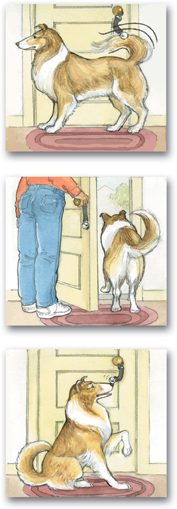Classical Conditioning One evening you sit down to eat a kind of food you've never tried before. But shortly after you start eating, you get sick from a stomach virus. You feel better the next day, but as your parents present you with leftovers of the same food, you feel sick again. From that time on, whenever you smell that particular food, you become nauseated. This is an example of classical conditioning. Classical conditioning is a form of learning in which a certain stimulus comes to produce a particular response, usually through association with a positive or negative experience. In this case, the stimulus is the smell of that particular food, and the response is nausea. The food didn't make you sick, but you've been conditioned to associate the smell of that food with illness.
Classical conditioning was first described around 1900 by Russian physiologist Ivan Pavlov, who was studying dogs' responses to food. Pavlov first noted that dogs salivate as an innate response to food. Then Pavlov discovered that if he always rang a bell when he offered food, a dog would salivate whenever it heard a bell, even if no food was present. Pavlov's experiment produced salivation (a response) in reaction to the bell (a stimulus) associated with food.

FIGURE 29–4 Operant Conditioning A dog randomly brushes its tail against a bell hanging on a doorknob (top). The owner responds by opening the door to let the dog outside (middle). After the “ring the bell; open the door“ sequence has occurred several times, the dog has learned to ring the bell when it wants to go out (bottom).
dOperant Conditioning Conditioning is often used to train animals. Operant conditioning occurs when an animal learns to behave in a certain way through repeated practice, to receive a reward or avoid punishment. Operant conditioning was first described in the 1940s by the American psychologist B. F. Skinner. Skinner invented a testing procedure that used a box called a “Skinner box.” A Skinner box contains a colored button or lever that delivers a food reward when pressed. After an animal is rewarded several times, it learns that it gets food whenever it presses the button or lever. At this point, the animal has learned by operant conditioning how to obtain food. In Figure 29–4, you can see how a dog can be trained to ring a bell to be let out of the house.
Operant conditioning is sometimes described as a form of trial-and-error learning. Trial-and-error learning begins with a random behavior that is rewarded in an event called a trial. Most trials result in errors, but occasionally a trial will lead to a reward or punishment.
Insight Learning The most complicated form of learning is insight learning, or reasoning. Insight learning occurs when an animal applies something it has already learned to a new situation, without a period of trial and error. For instance, if you are given a new math problem on an exam, you may apply principles you have already learned in the class to solve the problem. Insight learning is common among humans and some other primates. In one experiment, a hungry chimpanzee used insight learning to figure out how to reach a bunch of bananas hanging overhead: It stacked some boxes on top of one another and climbed to the top of the stack. In contrast, if a dog accidentally wraps its leash around a tree, the dog is usually unable to figure out how to free itself.
Table of Contents
- Formulas and Equations
- Applying Formulas and Equations
- Mean, Median, and Mode
- Estimation
- Using Measurements in Calculations
- Effects of Measurement Errors
- Accuracy
- Precision
- Comparing Accuracy and Precision
- Significant Figures
- Calculating With Significant Figures
- Scientific Notation
- Calculating With Scientific Notation
- Dimensional Analysis
- Applying Dimensional Analysis




